School-located vaccination clinics (SLVs) have played an integral role in child and adolescent vaccination for decades, including during the COVID-19 pandemic. SLVs can provide critical opportunities for flu routine and catch-up vaccination for children. Additionally, SLVs are an important strategy for promoting vaccine access.
In the SLV Toolkit, find resources for schools and immunization partners that can support and simplify SLV operations during and outside of a pandemic.
Learn more about AIM’s SLV efforts, in partnership with the National Association of School Nurses. Email AIM with questions or suggestions for toolkit resources.
School-Located Vaccination Clinics Reports
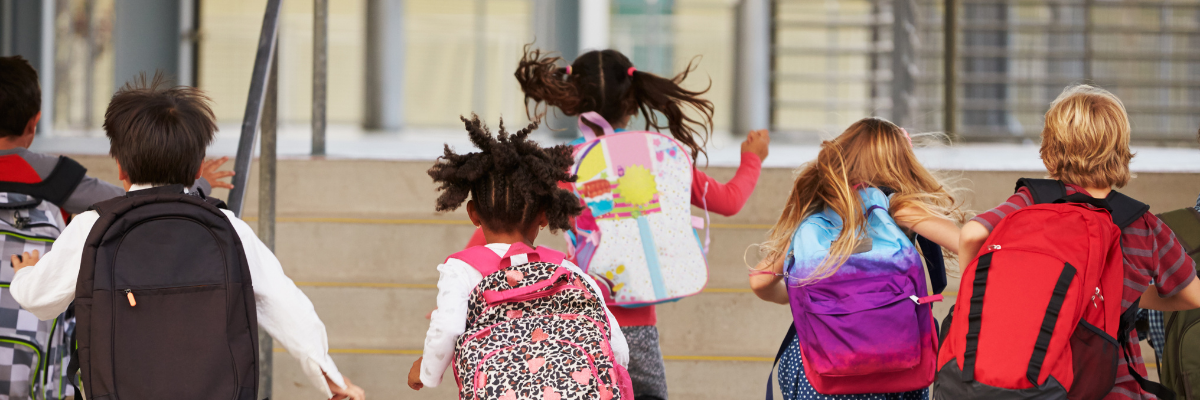
In 2021, AIM and the National Association of School Nurses (NASN) released a pair of reports detailing the role school-located vaccination clinics (SLVs) played during the COVID-19 pandemic and opportunities for their use for flu, COVID-19, and catch-up vaccination.
While the pandemic is over, the information gathered, and resources developed in this toolkit remain relevant to prevent the spread of outbreaks of vaccine-preventable diseases. The resources are an established strategy for increasing influenza and catch-up vaccinations through SLVs.
Decades of research have shown SLVs’ potential to increase vaccination coverage, but these reports are the first to provide insight into the SLV landscape during the unprecedented challenges presented by the COVID-19 pandemic. The pair of reports outline findings of a Mathematica-conducted roundtable and environmental scan.
These reports offer schools and immunization partners interested in SLV tips for getting started and simplifying SLV operations during and outside of a pandemic. Key takeaways from the report demonstrate that SLVs can support a safe return to school and critical opportunities for flu and catch-up vaccination for children.
Additionally, the report demonstrates SLV as an important strategy for promoting vaccine access. Learn more in our press release, or watch the archived School-Located Vaccination Symposium recording here.
AIM and NASN SLV Promotional Toolkit: School-Located Vaccination Clinics
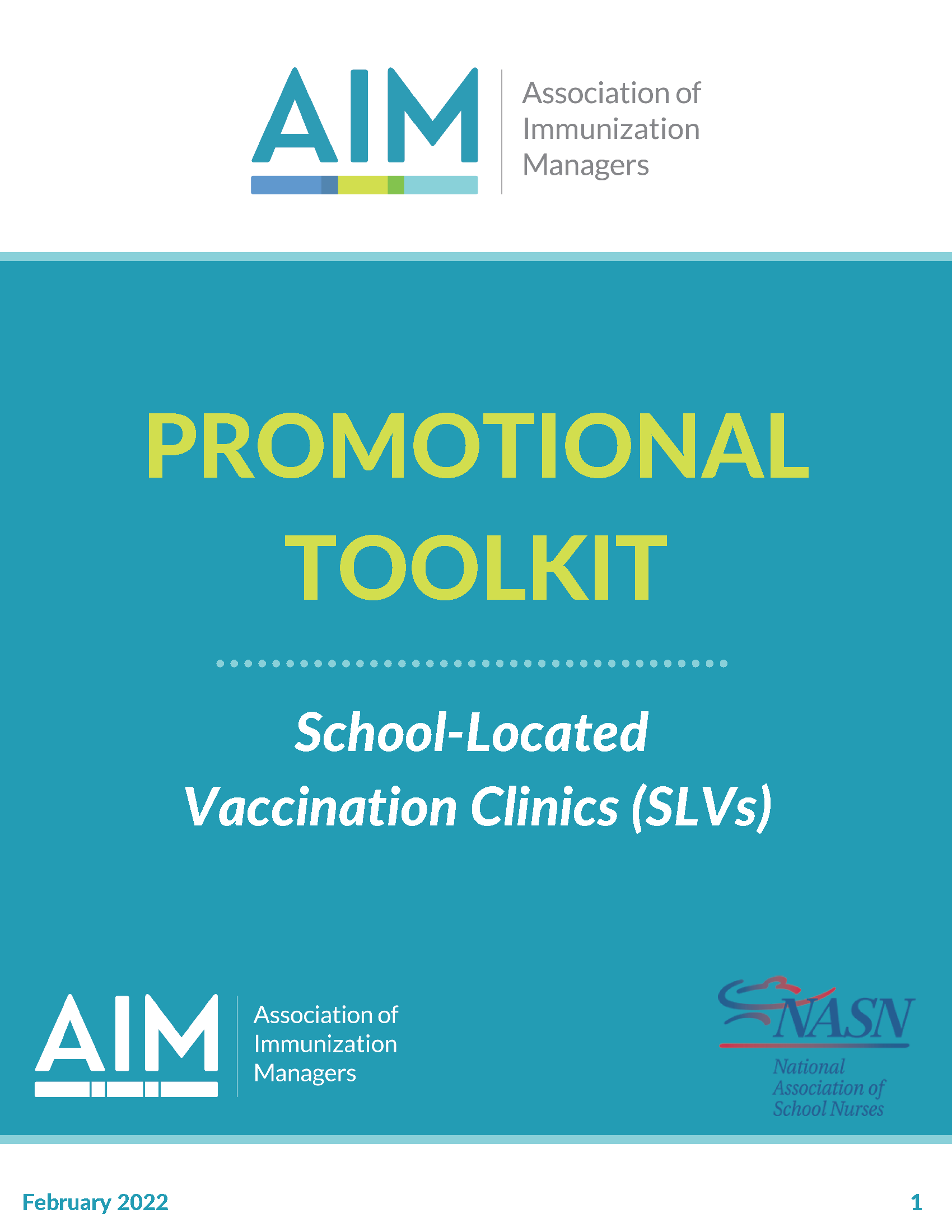
To support schools and leaders in K-12 education, public health professionals, health care providers, and other stakeholders from the immunization community, the Association of Immunization Managers (AIM) and the National Association of School Nurses (NASN) partnered to produce informational resources regarding school-located vaccination (SLV) clinics and to share best practices for improving childhood and adolescent immunization rates in school settings. From this partnership came a “School-Located Vaccination Clinics Toolkit” on AIM’s website, which incorporates a variety of insightful SLV resources. To ensure that the School-Located Vaccination Clinics Toolkit reaches stakeholders in education and members of the public health community, the following promotional toolkit was designed for dissemination by partner organizations through network communication, listservs, and social media platforms.
Toolkit Resources (from 2022)
SLV Toolkit Webinars
Opportunities to Improve School and Community Health Through School-Located Vaccinations
AIM and the National Association of School Nurses (NASN) hosted this webinar on October 26, 2021, to promote school-located vaccination (SLV) as a measure to improve and maintain a safe and healthy environment for students and the community. The webinar provided a brief overview of the AIM/NASN Environmental Scan and Roundtable documents with a state immunization director, school nurse leader, and school leader providing insight on their role as SLV champions and the importance of their role in the success of SLVs.
Webinar Speakers:
Linda Mendonca, MSN, MEd, RN, APHN-BC, NCSN, FNASN
Kathy Marceau, BA
Eva Stone, DNP, ARNP
Joseph Ellison III, EdD
Symposium Welcome
The “School-Located Vaccination (SLV) Strategies to Increase Child and Adolescent Immunization Rates During the COVID-19 Pandemic” 2021 virtual symposium brought together stakeholders for an insightful discussion regarding best practices and innovative models for School-Located Vaccinations, as well as addresses the challenges of SLVs. It is evident that, due to the COVID-19 pandemic, many children across the country fell behind on routine vaccinations. Through partnership and coordination of SLV stakeholders, SLVs were a critical tool for expanding vaccine access and building vaccine confidence. Click the “Welcome” video link to hear enriching discussions from Mark McClellan, MD, Ph.D. , director of the Duke-Margolis Center for Health Policy, Claire Hannan, MPH, executive director of the Association of Immunization Managers, and Bruce Gellin, MD, MPH, chief of global public health strategy at The Rockefeller Foundation.
A Call to Action on Childhood Immunizations
In this segment of the virtual symposium, Rachel L. Levine, MD, former assistant secretary for health at the U.S. Department of Health and Human Services, provided opening remarks and a call to action to increase routine vaccination in children (and adults), which slowed significantly during the pandemic. Additionally, hear remarks and gain beneficial resources from other federal partners, including Mary Wall (White House COVID-19 Response Team) and Tara Vogt, Ph.D., MPH (Immunization Services Division, NCIRD, CDC).
Rising to the Challenge: Innovative Strategies for Mobilizing K-12 Schools as COVID-19 Vaccination Sites
Tune in to the “Rising to the Challenge” segment of the virtual symposium to hear from SLV stakeholders and representatives from school districts across the country on innovative strategies and their experiences implementing successful and sustainable school-located vaccination clinics. Panelists included Tiffany Tate, executive director of the Maryland Partnership for Prevention, Sara Rigel, health services administrator for school-based partnerships and child care health for Public Health – Seattle and King County, Kaetlin Miller, program manager COVID-19 vaccine program for Public Health – Seattle and King County, and Gabriella Durán Blakey, chief operations officer at Albuquerque Public Schools.
Playing Catch-Up: Partnerships to Improve Routine and Seasonal Childhood Immunizations
In the “Playing Catch-Up” segment of the virtual symposium, panelists discussed current gaps and challenges in routine childhood vaccinations and methods to improve immunization rates for school-age children and adolescents. Panelists in this session included Ronald Balajadia, immunization branch chief for the Hawai’i Department of Health, Eva Stone, manager district health services for Jefferson County, Kentucky, and Judith Shlay, associate director of the Public Health Institute at Denver Health.
If You Build It, Will they Come? Strategies for Communicating With Parents and Building Vaccine Confidence
In the “If You Build It, Will They Come?” segment of the virtual symposium, listen to discussions regarding strategies for building vaccine confidence in communities through effective communication with parents and students. When it comes to SLVs, building the clinic is only half the battle, as communication with parents is crucial to successful program implementation. Despite the continuous dissemination and availability of vaccine information online, it remains vitally important to keep up the positive messaging and reduce misinformation in all mediums, specifically on social media. Panelists in this session included Judy Klein, president and founder, of Unity Consortium, Kathleen Ryan, associate division chief for pediatric infectious disease at the University of Florida Health, and Timothy Benally, founder of the Indigenous Peoples Student Association at Penn State University.
Tip Sheet: Communication Strategies for Promoting COVID-19 Vaccination in Schools
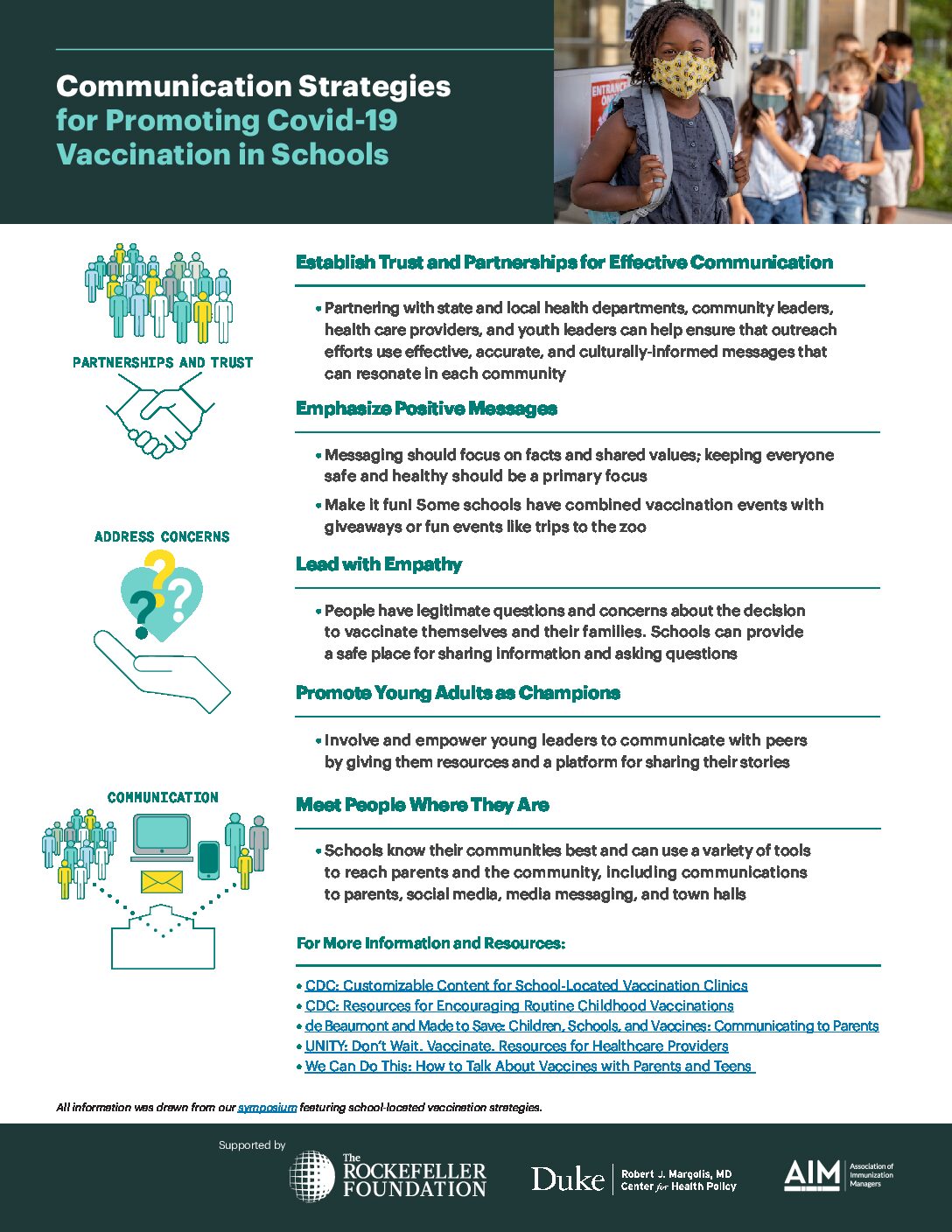
This tip sheet provides information that was drawn from the September 2021 Duke-Margolis Center for Health Policy and the Association of Immunization Managers partner virtual symposium on communication-specific strategies for a school located COVID-19 vaccination in schools highlighting the crucial elements of trust and partnerships, emphasizing positive messaging, leading with empathy, promoting youth as champions and more!
Infographic: COVID-19 Vaccination for Children Under 12 – How Schools Can Prepare To Be Vaccination Sites
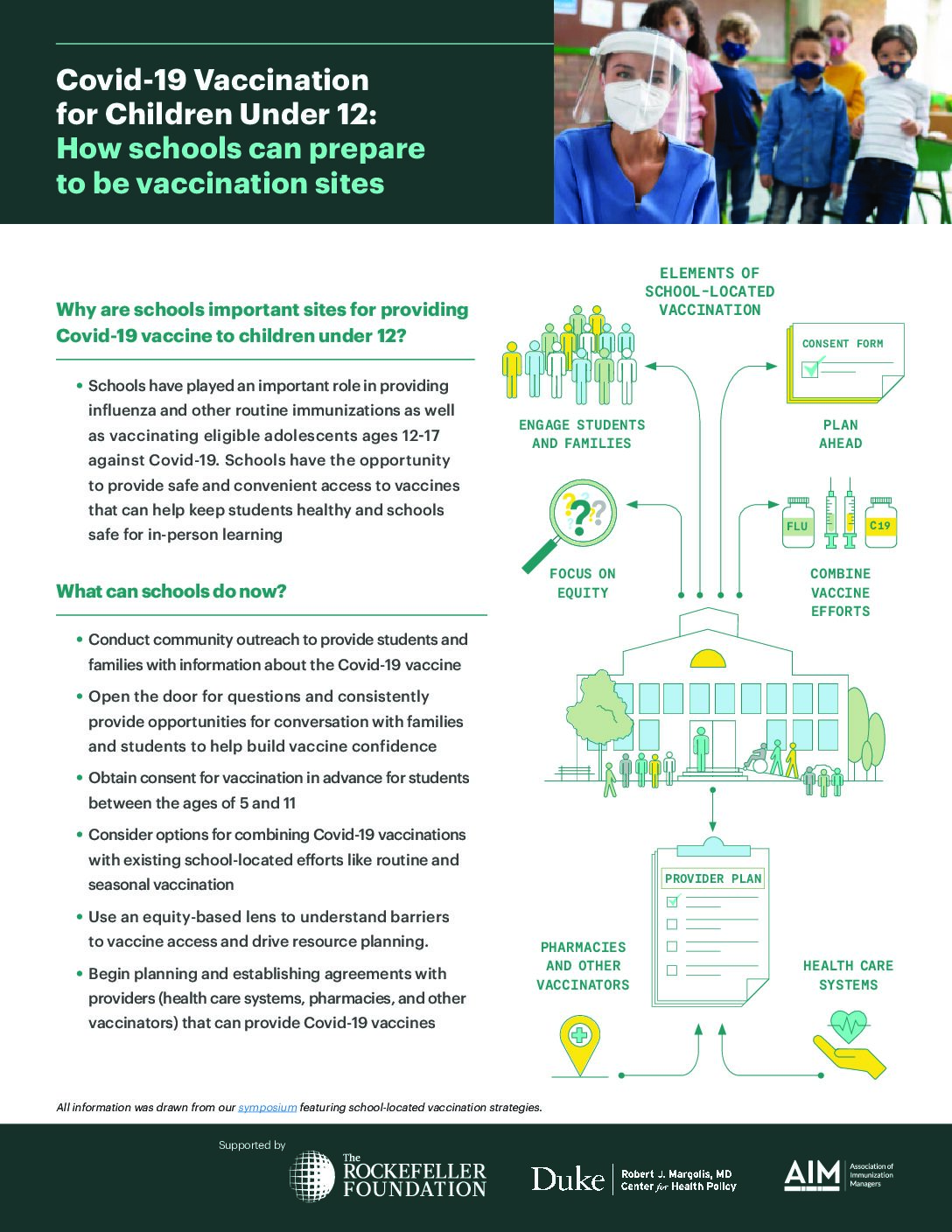
This infographic highlights specific strategies gleaned from the September 2021 Duke-Margolis Center for Health Policy and the Association of Immunization Managers partner virtual symposium for schools to prepare to be COVID-19 vaccination sites for children under 12 including outreach, consent, combining with existing school-based vaccination efforts, leading with equity, and more!
Check List: FAQ for School Leaders – Successful Strategies for Vaccination in School Settings
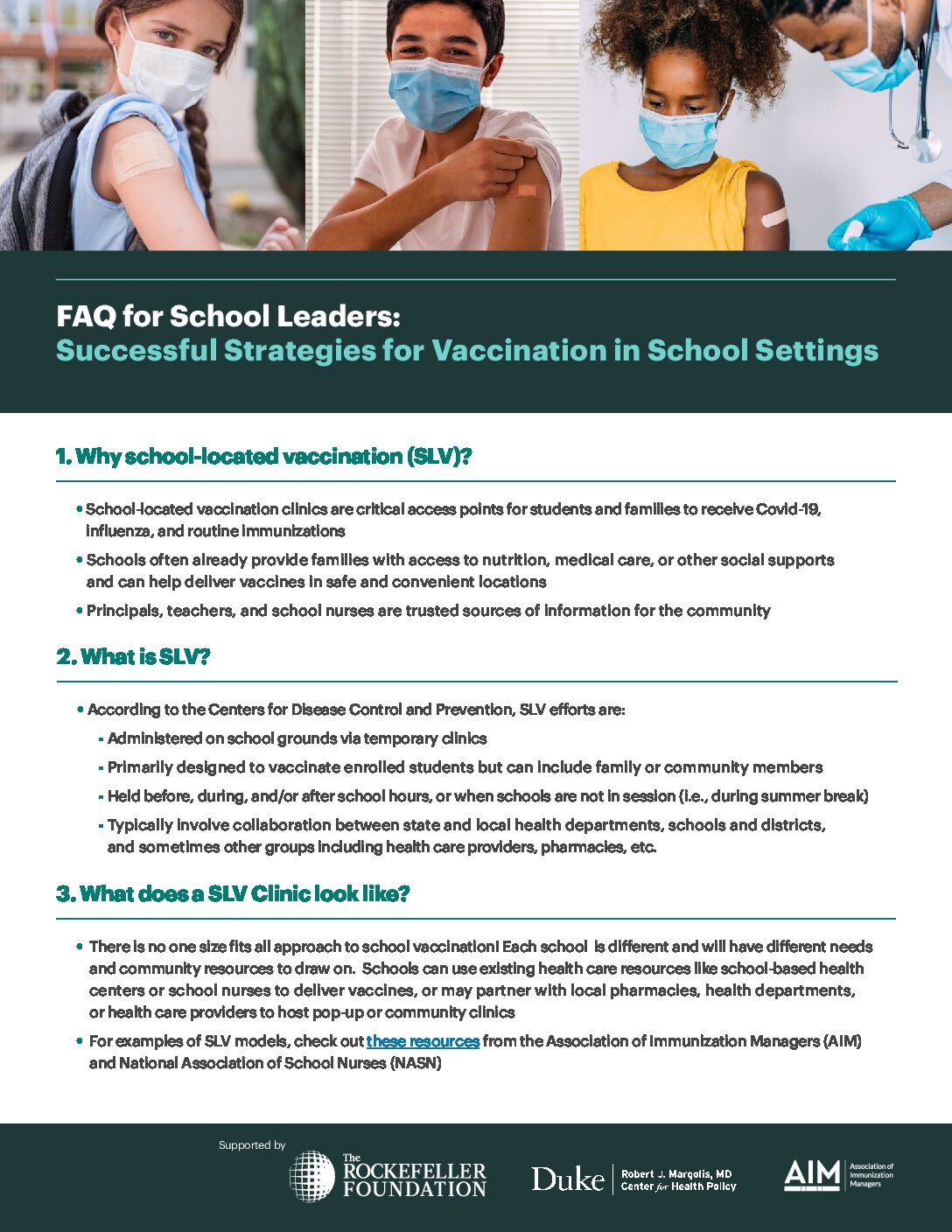
Duke-Margolis Center for Health Policy and the Association of Immunization Managers hosted a virtual symposium in September 2021 that brought together public health officials, leaders in K-12 education, health care providers, and other stakeholders from across the immunization community to share best practices for improving childhood and adolescent immunization rates in school settings. Speakers shared innovative models and lessons learned for school-located COVID-19 vaccination sites, communications strategies for engaging families, and building vaccine confidence and opportunities to strengthen partnerships between public health, education, and health care providers to improve child and adolescent vaccination rates.
These FAQs provide information that was learned from the symposium for school leaders in considering SLVs in their school setting and answer basic questions: Why SLV? What is SLV? What does an SLV Clinic look like? What makes SLV successful?
Tip Sheet: School-Located Vaccination Clinics in the Context of COVID-19
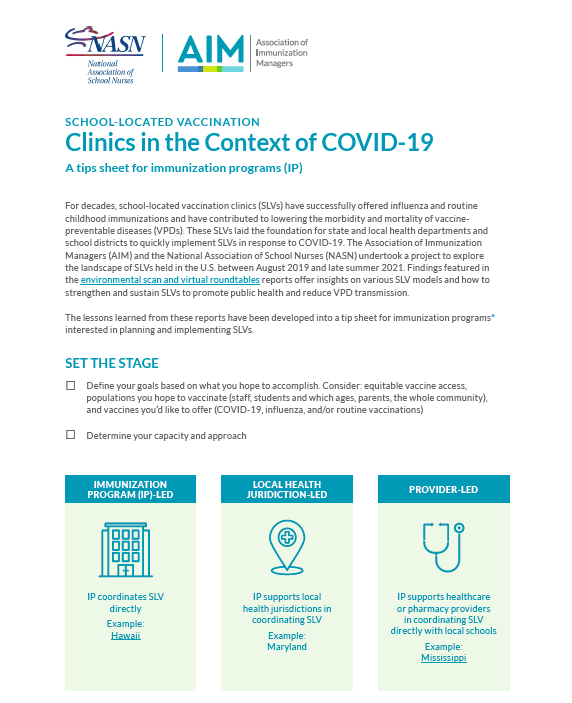
For decades, school-located vaccination clinics (SLVs) have successfully offered influenza and routine childhood immunizations and have contributed to lowering the morbidity and mortality of vaccine-preventable diseases (VPDs). These SLVs laid the foundation for state and local health departments and school districts to quickly implement SLVs in response to COVID-19.
AIM and the National Association of School Nurses (NASN) undertook a project to explore the landscape of SLVs held in the U.S. between August 2019 and late summer 2021. Findings featured in the environmental scan and virtual roundtables reports offer insights on various SLV models and how to strengthen and sustain SLVs to promote public health and reduce VPD transmission.
The lessons learned from these reports have been developed into a tip sheet for immunization programs interested in planning and implementing SLVs.
Checklist: School-Located Vaccination School Nurse Planning
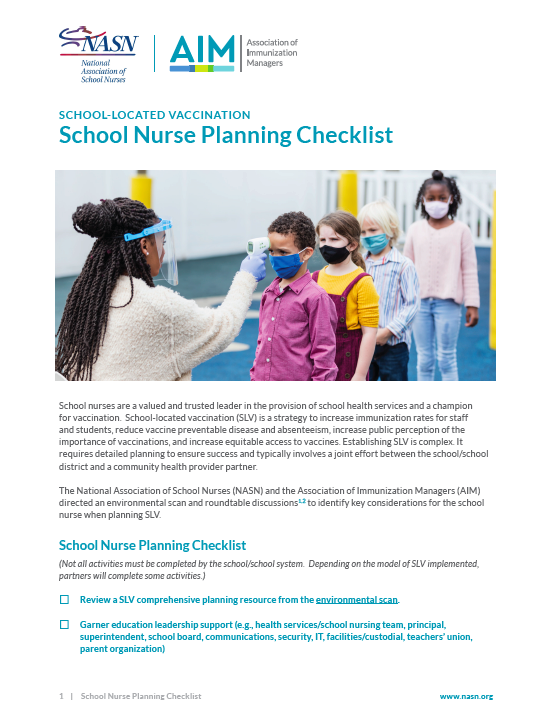
School nurses are a valued and trusted leader in the provision of school health services and a champion for vaccination. School-located vaccination (SLV) is a strategy to increase immunization rates for staff and students, reduce vaccine preventable disease and absenteeism, increase public perception of the importance of vaccinations, and increase equitable access to vaccines. Establishing SLV is complex. It requires detailed planning to ensure success and typically involves a joint effort between the school/school district and a community health provider partner.
The National Association of School Nurses (NASN) and the Association of Immunization Managers (AIM) directed an environmental scan and roundtable discussions to identify key considerations for the school nurse when planning SLV.
